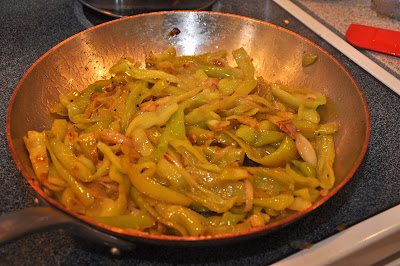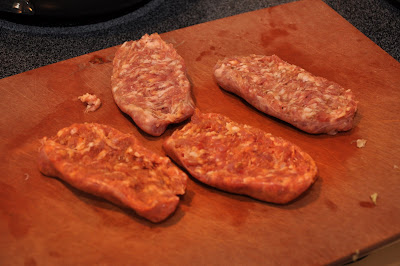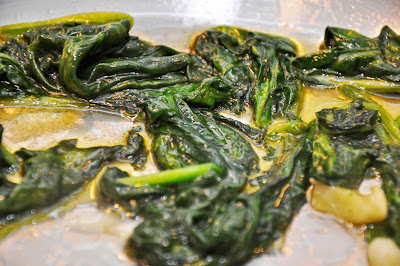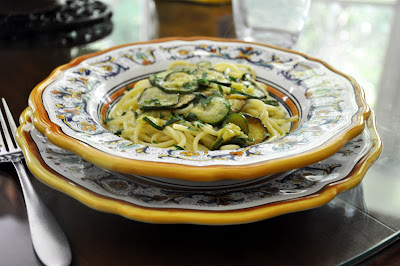 |
| My love of food goes back a long way! |
Hard to believe, but it's been one whole year since I started this blog with a short welcome message and a promise to fill it with my favorite recipes. Well, I'd like to think that I've made good on that promise with the nearly 200 recipes I've posted since then. In fact, I've covered most of my personal favorite dishes and provided what I might immodestly call an in-depth, if hardly exhaustive, overview of cuisines of the two regional Italian cuisines I know best, those of Naples and Rome. If I do say so myself, if you are looking for an overview of these cuisines, you could do worse than look here.
Over time, as I have learned more about this odd pastime called food blogging, I've come to realize that Memorie di Angelina is actually very different in both intent and content from what a lot of my fellow bloggers are up to. For one thing, the primary—almost exclusive—focus is on the food and how to cook it, described not in traditional recipe format but in what I like to call 'food stories', with a focus on the experience of cooking rather than exact measurements and cooking times. Whenever my knowledge and time allow, these stories include a little historical and cultural context to help the reader understand the origins of a particular dish, its evolution over time, and the possible variations in preparation and ingredients. Luckily, my chosen subject, Italian cuisine, provides fertile ground to this sort of culinary tilling.
| Another kind of tilling: yours truly tending the zucchini plants in my Roman garden... |
The result, I hope, is both informative and entertaining, but perhaps less personalized than other food blogs you are likely to encounter. I'll tell you about the experiences that have shaped my cooking and thinking about food, but you'll rarely if ever read here about my personal problems, or how much my guests or family may have liked or disliked a dish, or any of those little personal touches that can make a blog so charming. Yes, I would like to charm you, dear reader, not with the compelling but false sense of intimacy that the internet can encourage, but with passion for my subject and attention to all the little details that makes for truly good cooking.
| The fruits of my labor on our kitchen table. This is what good food means to me. |
Memorie di Angelina does not try to be innovative, creative or original. It's not about 'fancy' food. It's not about the newest 'fad'—have you seen any cupcakes on this blog?—or simply about what we've been eating at home, although, yes, everything you see here is what's been for dinner at home. In fact, I've been systematic about trying to cover the most classic, iconic home dishes of each region of the peninsula, first and foremost my nonna Angelina's home cooking from Campania and the lusty cooking of Rome, where I lived for so many years, but also classics from other regions, from the Venetian classic risi e bisi to Sicily's pasta alla Norma. In short, more than a blog, this website aspires to be an online cookbook, a resource for learning about and preparing the best of Italian home cooking.
| Back to my roots: majestic Mount Vesuvius ... |
One rude awakening that has shaken me a bit over the past year is the extent to which blogging—like the internet itself—is a visual medium. That's been a real challenge. I've never been much for food styling. You'll hardly ever see any garnish on my dinner plate other than the occasional lemon wedge for fish. And I'll be the first to admit, you will not find the best food photography on the web here at Memorie di Angelina. And yet photography is the thing that is supposed to attract readers and separate the truly 'big' blogs from the myriad others. I've wanted to improve the photos here for quite a while, even went out and bought myself a fancy dSRL camera and some lighting equipment. But this blog being a labor of love that I squeeze in—mostly on the weekends—whenever my day job allows, it has been a struggle to find the time to master an art that is as complex as cooking itself.
But even if I did become the next Lou Manna, sometimes I wonder whether this blogging business isn't, at bottom, an exercise in futility. For me, food is fundamentally about taste and texture. But, ironically, those are the two sensations that are hardest to convey in words or pictures. Neither writing nor photography will ever be a substitute for actually experiencing the taste and 'mouth feel' of a dish. And some of the best eating, especially when it comes to home cooking which is the focus of this blog, does not make for a pretty picture. Nor can it really be captured in words—the English language, its huge vocabulary notwithstanding, fails when it comes to these sensations. (Think, for example, of all the sublime and ridiculous terms of art that wine connoisseurs resort to.) Sometimes frustration with this basic limitation of the medium can drive me almost to despair.
And yet, this quirky blog, with its odd, unpronounceable 'foreign' name, 'plain Jane' graphics, too much text and mediocre photography has, seemingly against all odds, met with a modicum of success. As I've proudly pointed out before, the regular readership of Memorie di Angelina has been growing steadily into the thousands and its online traffic comes, quite literally, from all over the world: about one third from here in North America and the rest from large contingents from Europe, Latin America, Asia and Africa. It's the second most popular blog under cooking and recipes, and the third most popular under food, on NetworkedBlogs, the biggest blog directory on the web.
Well, now that I'm off my soapbox and done with my bragging and belly-aching, let me say it again: thank you all for your loyal readership and support. It means a lot. It's what keeps me at it, even when I'm feeling frustrated, even when I'm tired from a long week and would rather just veg' in front of the television and throw back a cold beer. That, and the love of cooking.
So what next for Memorie di Angelina? I'm lucky that my chosen subject is vast. I may have covered most of the 'greatest hits' of Rome and Naples, but there is much more out there to explore. And other regions to cover as well, in particular the other cuisines of central Italy that I love so much: Tuscany, Umbria, Abruzzo and the area of northern Lazio known as the 'Tuscia'. And I have always wanted to learn more about the cooking of the rest of southern Italy, in particular Puglia, the region of Italy that my paternal grandfather Lorenzo—Angelina's husband—hailed from. And then there's Sicily, a region of Italy that I have always found rather mysterious, with its fascinating and colorful history which has produced a cuisine with unique blend of influences. But then, we mustn't forget about the refined cuisine of Piemonte, the Germanic-influenced cuisines of Alto Adige, Friuli or Trieste… In short, there's still a lot of ground to cover. Some of the more encyclopedic Italian cookbooks have literally thousands of recipes.
In the near future, I also want to make the growing collection of recipes that make up this website more easily accessible. I am tinkering with different strategies for allowing users to browse recipes more easily, perhaps through the use of indexes, so you can see the full gamut of dishes featured here by region, type of dish and so on.
And, finally, one of these days I want to get back to a project that has been on my 'to do' list ever since I began blogging—to introduce you to my grandmother Angelina, the lady whose wonderful home cooking inspired this blog. That, I hope, will be a post worth waiting for.
Thanks for your readership and happy cooking!
Frank
| The view from our backyard outside Rome, where we enjoyed so many al fresco dinners. |






